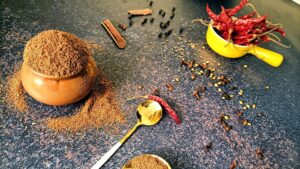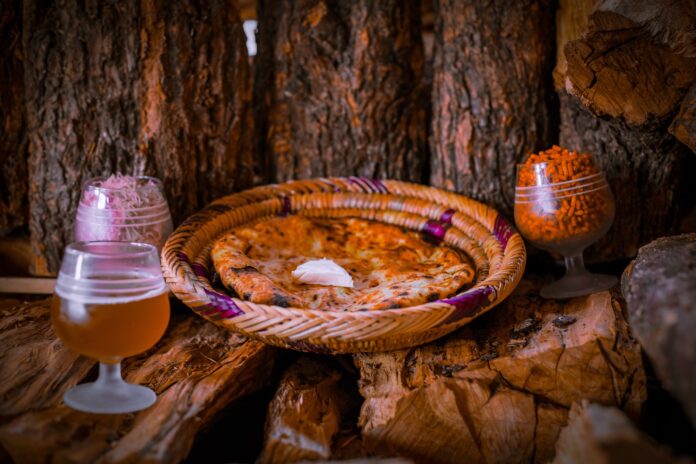Moroccan cuisine has a long history and has been influenced by many different cultures, including European, Arab, and Berber. The country’s location along the Mediterranean Sea and the Atlantic Ocean has also shaped its culinary traditions. During the Roman and Phoenician empires, Morocco was a major trading hub, which helped to introduce new ingredients and cooking techniques to the region.
The earliest influence on Moroccan cuisine came from the Berbers, the indigenous people of North Africa who have been in the region for over 10,000 years. The Berbers were known for their use of grains, vegetables, fruits, and meats in their dishes, and their simple culinary traditions are still evident in many Moroccan dishes today.
The first recorded influence on Moroccan cuisine came from the Arab conquest of the country in the 7th and 8th centuries and had perhaps the most pronounced and long-lasting effect on Moroccan cuisine. Arabs brought with them many new ingredients and cooking techniques. They brought their own spices and flavors to Moroccan cuisine, including saffron, cinnamon, and ginger, radically transforming the somewhat bland cuisine of the area and establishing a distinctive culinary tradition.

The Moors, who ruled Morocco for over 800 years till the 15th century, also significantly influenced the cuisine, introducing a wide range of spices, including saffron, cinnamon, and cumin.
In the 15th century, the Portuguese arrived in Morocco. They controlled the city of Ceuta on the Moroccan coast, and introduced new fruits and vegetables to the region, such as potatoes, tomatoes, and bell peppers.
The Spanish controlled the city of Melilla and substantially influenced Moroccan cuisine, particularly in the country’s northern regions. They introduced a variety of meats, including pork and chicken, as well as many seafood dishes.
Around 15th and 16th century, Morrocco saw a greater influx of European traders who brought ingredients such as sugar, honey, and spices from the Americas and Asia. These ingredients were used to create sweet and savory dishes that became popular among the Moroccan elite. In the 16th century, Morocco became a center of trade between Europe, Africa, and the Middle East, which led to the introduction of many new ingredients and culinary techniques.
The Moroccan culinary tradition was further influenced by the Ottoman Empire in the 16th and 17th centuries, with the introduction of new ingredients and cooking techniques, such as the use of yogurt and the adoption of the tagine, a traditional Moroccan stew.
In the 19th century, French and British colonization brought even more culinary influences to Morocco. It was a popular destination for European travelers and diplomats, and the country’s culinary traditions began to evolve to cater to their tastes. Dishes such as couscous and tagines were adapted to include European ingredients, such as lamb and chicken. The French introduced a number of their own dishes and cooking techniques, such as the use of butter and cream in sauces, while the British introduced tea drinking and the concept of afternoon tea.
Today, Moroccan cuisine continues to be influenced by a wide range of cultural influences, making it one of the world’s most diverse and delicious cuisines.
We can further drill down on the various Influences seen in the cuisine below for a better understanding of their impact overall.

- Arab and Islamic: Morocco has a long history of Arab and Islamic influence, and this is reflected in its cuisine. Traditional Moroccan dishes often feature ingredients and cooking techniques that are common in Arab and Islamic cuisine, such as the use of spices, herbs, and nuts. Their influence can be seen in many aspects of the cuisine, such as the use of spices like cumin, coriander, and paprika.
In addition, the use of ingredients like lamb, olives, and dates, which are commonly used in Moroccan cuisine. Lamb is a popular protein in Moroccan dishes and is often slow-cooked with spices and herbs to create rich and flavorful dishes. Olives and dates are also commonly used as ingredients in dishes and as accompaniments to meals.
- Ottoman Empire: The Ottomans also introduced the concept of meze, or small appetizers, and baklava, a sweet dessert made with layers of phyllo dough and filled with nuts and honey, which are commonly served in Morocco. Dried fruits and nuts are also widely used in Moroccan dishes as ingredients and as accompaniments to meals.
- Berber: The Berbers, also known as Amazigh, are indigenous people who live in North Africa, primarily in Morocco, Algeria, Tunisia, and Libya. They have their own distinct languages and cultures, and many still practice traditional ways of life, such as farming and herding. The Berbers have a long history in the region and have played a significant role in developing Moroccan culture and cuisine with their simple, rustic dishes made from locally sourced ingredients such as grains, vegetables, and fruits. These ingredients were often cooked over a fire or grilled.
They introduced couscous as a staple in Moroccan cuisine. Traditional Berber dishes often feature local ingredients and simple, flavorful cooking techniques. The Berber influence with their nomadic or semi-nomadic lifestyle is also evident in Moroccan cuisine and is reflected in their use of ingredients such as lamb, goat, and camel meat, as well as dried fruits and nuts.
- Mediterranean: Because of Morocco’s proximity to the Mediterranean Sea, the flavors and ingredients of the Mediterranean region have influenced its cuisine. This includes the use of fresh fruits and vegetables, as well as seafood and olive oil. Tomatoes and bell peppers are commonly used in Moroccan dishes as ingredients and as accompaniments to meals. Seafood is also widely used in Moroccan cuisine and is often grilled or baked with herbs and spices to create rich and flavorful dishes. The Mediterranean influence can also be seen in the use of herbs like parsley and mint, commonly used in Moroccan cuisine, to add flavor and freshness.
- Finally, the European influence can be seen in the use of ingredients like potatoes, carrots, and zucchini, as well as the use of dairy products like butter and cream.
Moroccan cuisine is a must for a food enthusiast. The experience is not just the food but a wide range of rich and diverse culinary traditions that reflect the country’s rich history and cultural heritage.
